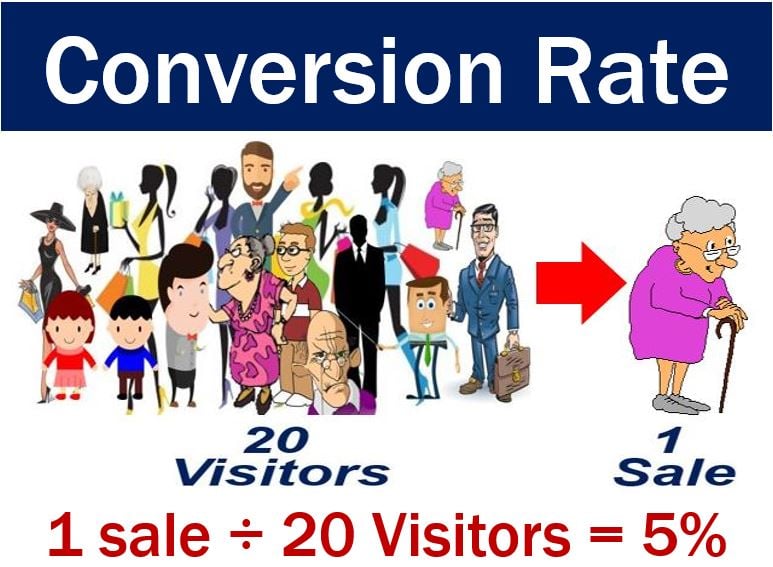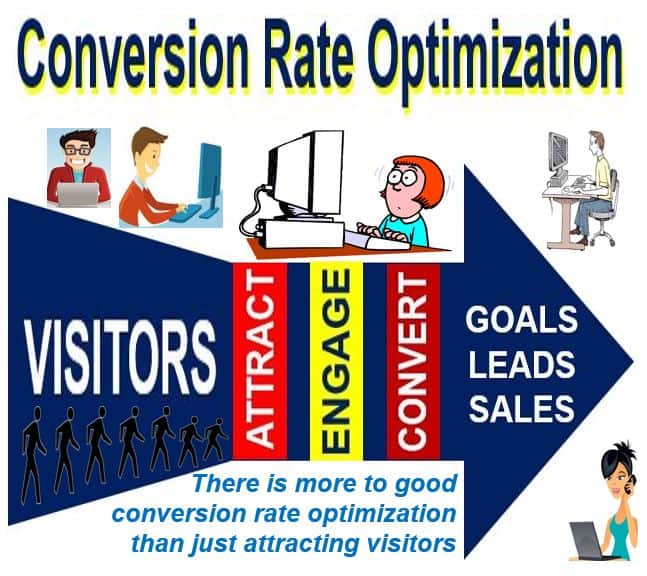The Conversion Rate in e-commerce refers to the percentage of visitors who do what the website desires. Examples include filling in a form, voting in a petition, and responding to a survey or questionnaire. The website may also want the visitor to subscribe to a newsletter, buy a product, or download software.
In other words, conversion rate refers to visitors who do what we hope they will do.
It forms part of ‘conversion marketing.’ Conversion marketing is the act of converting website visitors into paying customers. It is the act of getting them to do what we want.
Conversion rate – banner ads
We may also use the term to measure the proportion of web page visitors who click on banner ads. Banner ads are adverts that appear on a web page.
Some web pages have banner ads on them. Every time a visitor clicks on an ad, the website gets money. The term ‘ad clicks’ refers to how many times people clicked on the banner ads.
We divide the total number of visitors by the number of ad clicks. For example, if a web page received 1,000 visitors and 50 ad clicks, the conversion rate is 5%. See the calculation below:
50 ÷ 1,000 x 100 = 5% Conversion Rate

“Conversion rate is defined as the number of visitors to a website that completes a desired goal (a conversion) out of the total number of visitors. A high conversion rate is indicative of successful marketing and web design.”
Several factors determine whether conversion rates are high or low, including:
The appeal of the offer
An offer’s attractiveness depends on how effective the value proposition is. It also depends on how well you have presented it.
In most cases, impulse items have greater conversion rates than larger products. In other words, a higher percentage of visitors will buy a bar of chocolate than a car. Impulse buying is spur of the moment purchasing, i.e., the consumer had not planned to buy.
The website’s ease of use
The website must be easy to navigate and have clear explanations and instructions. Above all, the pages should load rapidly.
Grasping the underlying psychology behind visitor interactions online is key to tailoring strategies that can effectively boost conversion rates.

Visitors’ interest levels
The Internet marketing professional aims to match the right visitor, at the right time, and at the right place. This is crucial if you want to achieve optimum conversion rates.
The competition
If your offer is unique, your conversion rate will be greater than a website that has to compete with several others.
Generating offline responses
For websites that aim to generate offline responses, measuring conversion rates is not so easy. Examples of offline responses are telephone calls or human visits to a physical store.
Measuring responses is difficult because we cannot automatically trace a personal visit or phone call to its source. The source may have been a referral, the telephone directory (Yellow Pages), or a website.
Companies can overcome this problem by asking people how they heard about the business. The seller may also offer a toll-free number that people can only get from the website.
Where the response occurs within the website itself, the website’s analytics package can include a conversion funnel. The conversion funnel tracks visitor behavior.
Conversion Rate Optimization (CRO) is a system in Internet marketing. It increases the percentage of visitors who take a desired action.
The terms Conversion optimization or conversion optimization have the same meaning as CRO.
Conversion rate for currencies
We also use the term conversion rate when talking about currencies. It tells us how many units of one currency we can buy with another currency.
For example, a conversion of pounds sterling to US dollars of 1.32 means that £1 can convert to $1.32.
A high conversion rate means that we can ‘buy’ many units of the other currency.
We can also use ‘conversion rate’ when talking about sales people. For example, a door-to-door sales woman may average one sale for every 100 houses she visits. Therefore, she has a conversion rate of 1%.
Analyzing customer feedback on their purchasing journey can provide valuable insights for optimizing conversion strategies and enhancing user experience.
Compound phrases with the term “conversion rate”
A term that consists of two or more words is known as a compound phrase. There are many compound phrases containing the words “conversion rate” in business English. Let’s have a look at some of them:
-
Conversion Rate Optimization (CRO) Techniques
Strategies and methods applied to improve the likelihood of visitors performing desired actions on a website.
For example: “By implementing various Conversion Rate Optimization (CRO) Techniques, the website saw a significant increase in user engagement and sales.”
-
Conversion Rate Benchmarks
Standard metrics used to compare a website’s performance against industry averages.
For example: “The marketing team studied Conversion Rate Benchmarks to understand how their campaign performed relative to competitors.”
-
Conversion Rate Metrics
Quantitative measures that assess the effectiveness of sales, marketing, and customer experience initiatives.
For example: “Analysts regularly review Conversion Rate Metrics to refine their digital marketing strategies.”
-
Conversion Rate Goals
Specific targets set by businesses to achieve a certain percentage of successful customer conversions.
For example: “Setting ambitious yet attainable Conversion Rate Goals is crucial for motivating the sales team and tracking progress.”
-
Conversion Rate Fluctuations
Variations in conversion rates over time, which can be indicative of market trends, seasonal factors, or the impact of promotional activities.
For example: “The quarterly report revealed Conversion Rate Fluctuations that corresponded with the recent advertising push.”
Video What is Conversion Rate?
This educational video, from our sister channel on YouTube – Marketing Business Network, explains what ‘Conversion Rate’ means using simple and easy-to-understand language and examples.
